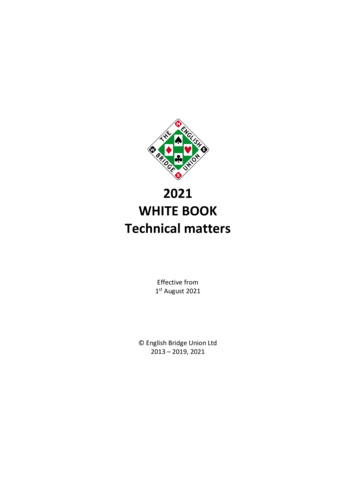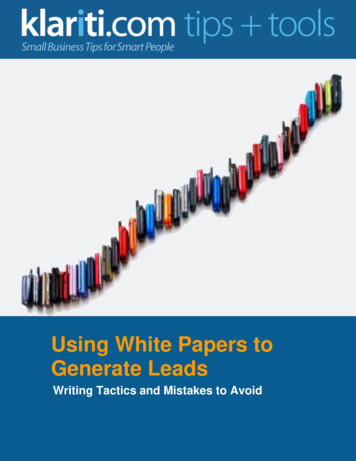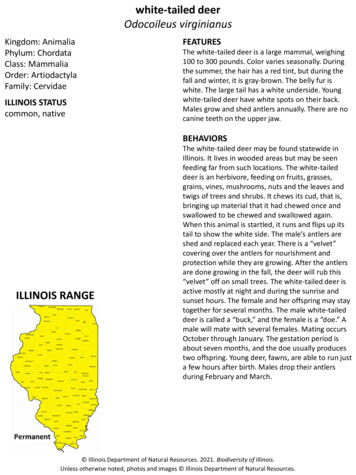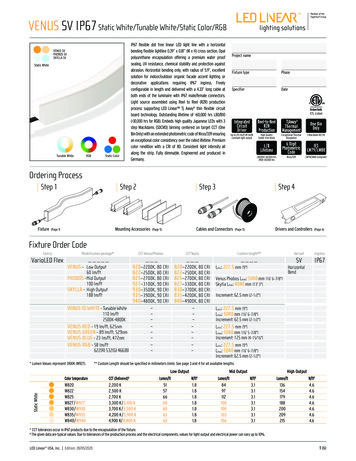
Transcription
White PaperThe Future of Life Insurance:Five Ways to Win
Boston Consulting Group partners with leaders inbusiness and society to tackle their mostimportant challenges and capture their greatestopportunities. BCG was the pioneer in businessstrategy when it was founded in 1963. Today, wehelp clients with total transformation—inspiringcomplex change, enabling organizations to grow,building competitive advantage, and drivingbottom-line impact.To succeed, organizations must blend digital andhuman capabilities. Our diverse, global teamsbring deep industry and functional expertise and arange of perspectives to spark change. BCGdelivers solutions through leading-edgemanagement consulting along with technologyand design, corporate and digital ventures—andbusiness purpose. We work in a uniquelycollaborative model across the firm andthroughout all levels of the client organization,generating results that allow our clients to thrive.
White PaperThe Future of Life Insurance:Five Ways to WinWalter Reinl, Anupam Sahay, and Tjun TangJune 2021
2 The Future of Life Insurance: Five Ways to Win
Life insurers find themselves at the beginning of what promises to be achallenging decade. Those that delay or attempt to cling to the status quo couldface the same mixed fortunes as those fixed-line telecom operators whose businessmodels were upended by technological and social change. In turn, insurers thatmove boldly to adapt their strategies, operations, and organizations to new realitiescan still expect to grow and prosper in the years ahead.A Challenging EnvironmentIn the 2020s, life insurers face stiff competition from a broad range of newcompetitors seeking to capture market share. Asset managers, segment specialists,multi-line financial institutions, conglomerate owners, back-book consolidators,private equity sponsors, and insurtech players are all trying to carve out their ownniches in the life insurance industry.Boundaries are blurring. Insurers will feel pressure to pick their battleground andconcentrate on specialties where they have sustainable advantage. Already, we seemany life insurers honing positions as protection specialists, investment managers,or next-generation distribution powerhouses.At the same time, the insurance industry is experiencing rapid adoption of bothdata analytics and digital technologies including AI. These technical changeshave ripple effects on customer expectations, operating cost structures, andbusiness models.As these changes take place, data analytics and AI will no longer be consideredparticularly innovative. Instead, they will be an intrinsic component of the waybusiness is done across the whole value chain. Despite their risk-averse corporatecultures and complex legacy IT systems, life insurers will have no choice but toadapt to keep up. China offers a glimpse into just how fast these changes can takeplace with early digital adopters like Ping An and new entrants such as Zhong An,Huize and Waterdrop initially leading the way, but traditional players now movingquickly to adapt.Boston Consulting Group 3
Meanwhile, low-for-longer interest rates and unusually flat yield curves willcomplicate the economics of the insurance business by reducing new money yield,increasing the value of liabilities, and reducing the consumer appeal of endowmentand annuity products versus alternatives such as deposits and fund products. Thesechallenges are especially severe for insurers in Japan, Europe, and the U.S. whereinterest rates may stay very low for the foreseeable future.At the same time, active regulation around capital adequacy, consumer protection,and distributor conduct will most likely end up shrinking risk appetite, changingdistribution dynamics, and hobbling certain traditional categories such as guaranteedreturn products. Risk-based capital regimes like the upcoming Hong Kong RiskBased Capital (RBC) framework are making traditional life insurance productseconomically less attractive to insurers. Insurers would like to push investmentlinked policies, but these products are not favored by sales agents due to lowercommission rates and requirements in some markets to disclose commissionearnings to customers.SHAPING UP TO WIN IN THE ‘20sTo overcome the challenges they face and win in the ‘20s, life insurers must addressfive related areas to better serve their customers and create value for shareholders(see Exhibit 1).Exhibit 1 How life insurers can win in the ‘20sShape New Avenues for Growth5Accelerate Bionic DistributionImprove Cost-to-Income RatioswaysMaximize Value from the In-Force BookRetool the OrganizationSource: BCG analysis4 The Future of Life Insurance: Five Ways to Win
Shape New Avenues for GrowthWhile insurers face increasing competition and regulation in their historical growthcenters, they also have new ways to grow. For example, rising demand for lifeinsurance in underpenetrated emerging markets, especially in Asia, seems likely tobenefit all insurers there over the next decade (see Exhibit 2). As these growthmarkets mature, domestic players will offer fierce competition, as they have alreadydone in China and India. Still, multinational insurers have opportunities to enter oraccelerate their business in these growth markets. Overextended companies shouldreview their portfolios and prune unprofitable lines of business to refocus theirattention on markets where they can win and profit.The life insurance sector will see further unbundling and modularization. The riseof simple digital offerings will accelerate this unbundling and product innovation.The ongoing divergence of Protection from Pensions & Savings will also continue.Insurers will develop partnerships with players from other industries while usingvalue-added services to complement and enrich products. They will package theseproducts into “services” or “life solutions” such as wellness offerings for healthierlives or investment services that enhance wealth. The most successful firms will bethose that reevaluate their product strategies to innovate in ways that meetchanging customer needs and desires across market segments.Exhibit 2 Emerging markets hold promising growth opportunities for life insurersCountryGWP CAGR 2014–2019 (in %)GWP gypt15Morocco11Kenya9NamibiaSouth Africa511Colombia10Mexico9Brazil8ChilePeru7Size: 50.000 USD millionNote: GWP Gross Written Premiums (in USD million); CAGR Compound annual growth rateSource: BCG analysisBoston Consulting Group 5
Insurers will need to develop specialized technical skills and build their capabilitiesin asset management and wealth management to tap into some of the most promising growth opportunities. The retirement space, for instance, offers a ‘wall ofmoney,’ especially in mature markets where demographics are driving a massiveswitch from accumulation to decumulation. Those mature markets are also seeinga shift from defined benefits to defined contribution retirement plans.Health insurance is another promising adjacent space for life insurers. TheCOVID-19 pandemic has made health generally and health insurance specifically amajor concern for many consumers. There are natural linkages between lifeinsurance and health insurance, although health insurance tends to benefit frommuch higher customer engagement. The economics of the health business can varyconsiderably between Individual and Group segments, as well as Indemnity versusFixed-benefits products. Health insurance is shifting from protection-based products toward value-added prevention and wellness services with the rise of telemedicine, testing, tracking, and chronic disease-advisory. To succeed in this space,life insurers will need to establish partnerships, develop a clear strategic focus,define a unique customer proposition, and build their health insurance expertise.Companies in many industries from e-commerce to telecommunications are eagerto find new ways to monetize their customer base. This gives insurers an opportunityto form partnerships and acquire new customers by joining ecosystems with largeexisting customer bases. The challenge for insurers will be to improve the economics of acquisition and conversion by using sophisticated data analytics and toreimagine the customer experience.Accelerate Bionic DistributionDigital technology and data-driven AI will complement, augment, and sometimesreplace human activity across many industries over the next decade. Life insuranceis not immune to this development. The insurers who win in the 2020s will bethose who shift toward a “bionic” operating model that combines advancedtechnological capabilities with a deft human touch (see Exhibit 3).For starters, insurers will need to figure out how to deploy a salesforce of bionicagents and advisors equipped with next-generation mobile digital tools, multisourced lead-flow, and advanced customer analytics to enable straight-through oreven pre-underwritten processing of customer applications.Insurers also have an opportunity to transform the advice that agents provide tocustomers. Such advice currently depends on the individual capability andjudgement of each agent, but AI could give agents analytically-driven prompts andnudges to make the most appealing offers at the right time that are tailored to theneeds and preferences of each customer.6 The Future of Life Insurance: Five Ways to Win
EXHIBIT 3 Bionic operating models combine the best attributes of humans and technology to deliversuperior outcomesExhibit 3 Bionic operating models combine the best attributes of humans and technology to deliversuperior outcomesOutcomesNew offers& servicesCustomerexperience &relationshipsEfficiency inoperationsTechnology:data anddigital platformHuman:org, ways ofworking, talentData& AIJourneyorgsTechStackDigitaltalentSource: BCG experienceBy combining the best human qualities of empathy and engagement with the rigorof AI, insurers can build a potent bionic salesforce. Of course, insurers will still needto recruit good sales agents and then train, incentivize, and manage them properly,but these activities too will benefit from technological support. In an era whereregulators and customers are both scrutinizing sales practices, technology canenhance salesforce productivity and deliver a superior customer experience.While banks have withdrawn from ownership of insurers since the global financialcrisis, banks and quasi-bank financial institutions still are important distributors ofthird-party life insurance products, especially in Asia and Europe. As banks rapidlydigitalize their operations and their customers increasingly “bank” through mobiledevices, old models that depended on customers walking into a branch to buy lifeinsurance from bank personnel or dedicated insurance specialists will becomeobsolete. Insurers and banks will both need to adapt to new technology-enabledBancassurance 3.0 models that feature offers based on comprehensive customerprofiles compiled from both bank and third-party data. Customers will access theseoffers through multiple types of journeys including online, mobile, offline, andhybrid/O2O (online-to-offline) journeys.Meanwhile, customer and platform owners across the world, including e-commerce,technology, mobility, and telecoms players, will continue their efforts to monetizetheir large customer bases through ecosystems and partnerships with productand service providers such as insurers. The European “Open Banking” decree willaccelerate this trend by requiring financial and non-financial players to share data.Boston Consulting Group 7
As a result, we anticipate rapid growth in the formation of both bespoke andopen-architecture partnerships between customer/platform owners and insurers. Toscale these partnerships commercially, insurers will need to speed up their productcycles, build seamless digital and O2O customer experiences, forge API-driven technology linkages, develop more flexible and agile cultures, and find ways to aligntheir economic interests with those of their new partners.In the past, life insurers thought that high acquisition costs and product complexitymade direct-to-consumer (D2C) sales impractical. In fact, experimentation byinsurtechs and examples like that of Assurance IQ (acquired by Prudential Financialin 2019) are paving the way for D2C insurance sales. The rapid growth of onlineterm life sales in India and mobile-driven demand for micro-insurance in emergingmarkets demonstrates the potential of the D2C channel. Not all D2C sales orcommunication will happen online. The most successful insurers will be those whofigure out how to guide customers through a seamless set of O2O interactionsacross digital, telesales, and advisory channels.Improving Cost-to-Income through Bionic OperationsFrom an operational perspective, the time is ripe for insurers to move beyondincremental improvements and embrace opportunities to drive down costs whilealso transforming the customer experience. To understand both the potential forimprovement and the scale of the challenge, consider the banking sector. Over thepast decade, many legacy banks have improved their cost-to-income ratios, but theystill face intense competitive pressure from neobanks.Here are six ways that insurers can improve their cost-to-income ratios:1. Root out operating costs by taking the next step beyond centralized processingto fully automate end-to-end processes and leverage the potential of roboticprocess automation (RPA).2. Reimagine customer journeys around human-centric design, while usingtechnologies such as digital identity, eKYC (Electronic Know Your Customer),OCR, facial recognition, and e-payments to save customers time and reducefriction. Pre-underwriting and GIO (Guaranteed Issuance Option) can accelerateautomation by reducing interruptions in the customer journey.3. Modernize the technology stack with greater use of modular architecture,third party software, API connectors, and cloud-based platforms. By placing adata and digital platform on top of legacy systems and leveraging the costbenefits and scalability of the cloud, life insurers can improve their agility andspeed-to-market (see Exhibit 4).4. Unleash the power of data by revamping data governance, architecture, andstorage, while building analytics and AI/machine learning capabilities. Insurersshould identify, pilot, and then scale up those use-cases that create the greatestdollar value and the most practical benefits for business users.8 The Future of Life Insurance: Five Ways to Win
Exhibit 4 Data and digital platform forms a key layer on top of core IT elementsData andanalyticsplatformOmni-channelexperience withsmooth customerjourneyInsurance data andanalytics, RPA/AISmart decisionenginesCommon datalayerCyber and data loudCore insuranceplatformInfrastructure/cloudInternal and external APIsSource: BCG analysis5. Enrich underwriting by combining third-party data with in-house data andcustomer-consented information to make better model-driven decisions,including pre-underwriting that can simplify and speed up both the customerand distributor experience.6. Streamline claims and seek to match the performance of P&C (General)insurers that offer rapid resolution/settlement, even for more complex claims.By taking action in these six areas, life insurers can significantly improve theiroperational efficiency and effectiveness, enabling step-change improvements incost curves.Extract Value from the In-Force BookThe Smart Multiple approach from the BCG ValueScience Center has shown thatmore than 80% of a company’s valuation variance can be explained by six factors,with ROTE (return on tangible equity) playing the most significant role (see Exhibit 5).Investors reward companies that can generate high returns on their existingcapital. For life insurers, this means that uplifting returns on their in-force bookscan generate better total shareholder return.Boston Consulting Group 9
Exhibit 5 BCG Smart Multiple approach demystifies valuationsSmart Multiple : 82% of the valuationvariance are explained by 6 factorsExample: Tracking of Stock Price ThroughBCG Smart Multiple ModelValue per share (HK )100100UnexplainedBCG Smart Multiple Level of China exposureStrong solvency ratioabove 300%Revenue mix %P&CDividend/TBV50Premium for exposure to growth marketDiscount associated with high levels ofexcess capitalDiscount associated with P&C exposureRegular dividends to shareholders boostsvaluationCredit ratingFinancial stability rewardedROTEPremium for high returns/net incomegeneration on capital base0Actual Hi-Lo range5002010 2011 2012 2013 2014 2015 2016 2017 2018 2019Source: BCG analysisMost life insurers, especially those in mature markets, derive profits and dividendsmostly from the in-force book, rather than the new business. Insurers can extractthe maximum value from their in-force book by focusing on ways to reduce unitcosts, enhance investment returns, and optimize capital in the back-book. They canuse data-driven analytics to build robust programs around increasing upsell andcross-sell business with existing customers.Ultimately, each insurer should review how it could enhance the value of the bookand determine whether it is the best owner-operator of the policies or whetherpolicyholders and shareholders could obtain a better outcome from a sale of the inforce policies to focused back-book consolidators.Retooling the OrganizationThe decade ahead will be filled with change for the life insurance industry. Tocompete and win in this era, life insurance leaders will need to transform theirorganizations in four main ways: 10 Add new talent and skills. The insurance workforce of the future will dependon modern technologists such as data scientists, AI and ML specialists, cloudarchitects, app builders, product developers, customer experience experts, andmore (see Exhibit 6). To find, hire, and build this type of workforce, insurers willhave to rethink the way they plan, recruit, train, and develop their people.The Future of Life Insurance: Five Ways to Win
Exhibit 6 Bionic insurers will need to upskill their employees to performmore digital and semi-digital al16%17%OthersCurrent WorkforceFuture WorkforceSource: BCG analysisFTE % Adopt agile ways of working. Today, insurers still often operate throughdepartmental silos that slow down speed and reduce efficiency. This type ofstructure and organization depends on sequential handovers between marketers,product developers, actuaries, IT, finance, compliance, and distribution thatundermine any attempts to accelerate product development. Like otherindustries, insurers can benefit from incorporating agile ways of working thatare cross-functional, collaborative, iterative, and goal-driven. Agile is easy todescribe, but difficult to master. The best approach is to launch agile pilotprojects, learn from experience, and then scale the most effective practicesacross the organization. Commit to ESG principles. As substantial employers and large institutionalinvestors, insurers should lead the way in ESG, with a clear purpose, diverseworkforce, sustainable operations, and ethical investments. Insurers with strongESG commitments may have an advantage when it comes to recruiting talent,engaging existing employees, and reducing both reputational and operationalrisks.A Time for Bold leadershipFor the insurance industry, the 2020s will likely be a decade of rapid change,intensifying competition, and challenging macroeconomic conditions. Insuranceleaders who avoid taking risks may well find themselves on a path of slow declineand fading relevance.Such a fate is not set in stone. Life insurers can thrive and transform themselves inthe ‘20s if their leaders take decisive action to empower employees, strengthenorganizational capabilities, and become more agile.Boston Consulting Group 11
Leaders will have to take measured risks – whether by uplifting capabilities, transforming the business model, pursuing acquisitions in attractive adjacent sectors,forging new partnerships, or outsourcing pieces of the value chain. They will alsoneed to plan for a wide range of business scenarios and consider all options toimprove the economics and balance sheet of the in-force business.The most successful insurers of the ‘20s will be those that meet the massive shiftsin their industry head-on. With a clear vision and a strong sense of purpose, boldinsurance leaders can guide their organizations through the turbulent years aheadwhile continuing to deliver both business and social value.For additional insights, please refer to these BCG publications: Advisors Still Matter to Life Insurance Customers Life Insurers May Find New Growth in Wellness Life—and Life Insurance—in a Time of Negative Rates A Growing Urgency for Change in the Life Insurance IndustryFind much more information in the Life Insurance section of BCG.com.12 The Future of Life Insurance: Five Ways to Win
About the AuthorsWalter Reinl is a managing director and partner at the Zurich office of BostonConsulting Group. You may contact him at Reinl.Walter@bcg.comAnupam Sahay is a managing director and senior partner at the Singapore officeof Boston Consulting Group. You may contact him at Sahay.Anupam@bcg.comTjun Tang is a managing director and senior partner at the Hong Kong office ofBoston Consulting Group. You may contact him at Tang.Tjun@bcg.comBoston Consulting Group 13
14 The Future of Life Insurance: Five Ways to Win
For information or permission to reprint, please contact BCG at permissions@bcg.com.To find the latest BCG content and register to receive e-alerts on this topic or others, please visit bcg.com.Follow Boston Consulting Group on Facebook and Twitter. Boston Consulting Group 2021. All rights reserved.06/21
bcg.com
Health insurance is another promising adjacent space for life insurers. The COVID-19 pandemic has made health generally and health insurance specifically a major concern for many consumers. There are natural linkages between life insurance and health insurance, although health insurance tends to benefit from much higher customer engagement.











